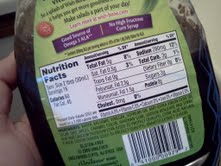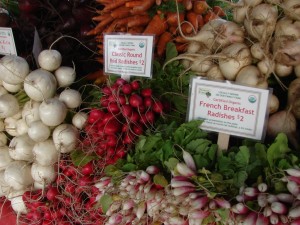
Nutrition is the foundation of athletic success. Your body's "fuel" is at least 80% of an effective training program. You can work out 7x week but without proper nutrition and hydration, you won't achieve your goals. Sports nutrition is not only about what you eat, but when, how often and why. High school athletes: this is an especially important site for you as you build lean muscle and work toward your goals.
You’ve probably read the phrase “smart substitutes” in some of my previous posts. If you’re trying to lead a healthier lifestyle or lose some weight (or both), then these two simple words can change everything for you. Take them to heart and know that by choosing a few “smart substitutes” on a consistent basis, you make some pretty big changes without feeling much sacrifice.
 Making smarter choices by going with substitutes for foods higher in fat or calories requires a little detective work, but you can handle it. You’ve got to read labels. Yes, I know you’re often in a hurry at the grocery, but simply grabbing what’s handy, on sale, or new is not a component of a healthy lifestyle.
Making smarter choices by going with substitutes for foods higher in fat or calories requires a little detective work, but you can handle it. You’ve got to read labels. Yes, I know you’re often in a hurry at the grocery, but simply grabbing what’s handy, on sale, or new is not a component of a healthy lifestyle.
Think of the grocery as a peaceful time to focus on your goals. Give yourself some extra time to read labels, make carefully considered choices, and to picture yourself healthier and happier. Exercising control over your food purchases means a far riskier situation at home, health-wise. With smart shopping choices being made in the store, healthier nutrition becomes much easier at home, whether you’re grabbing a snack or cooking a meal from scratch. Simple modifications to your menu – using smart choices – can literally save hundreds of calories and tons of fat.
The biggest label no-no is sugar. If sugar (or a form of sugar) is one of the first three ingredients listed on a package, that likely means that particular food or drink is very high in sugar. Choose a substitute.
Give yourself a double boost by eating wisely at breakfast to kick-start your day. Replace pork bacon or sausage with turkey or soy. The difference in calories is shocking, and the taste is still there.
Replace a donut or Danish with an English muffin spread with natural peanut butter and fruit spread. I promise you, you’ll be satisfied. Opt for whole wheat toast or bagels, and trans-free canola margarine instead of butter. Omega-3-enriched eggs, egg whites or egg substitutes are also smart substitutes. Replace cornflakes and milk with bran flakes and skim millk.
Light mayo is crucial to weight maintenance; keep it in the fridge. Turn your breaded chicken or fish patties into the grilled variety, and try some of today’s amazing veggie burgers. Don’t tell the family up front they’re about to experience a change; there’s every chance the new flavors will appeal.
Side dishes can add loads of unnecessary fat and calories. Substitute brown rice, steamed veggies, tossed salad with vinaigrette, fruit salad or carrot sticks for fries, potato salad, or white rice. Have you noticed how many white foods I’m recommending a substitute for?
Your new favorite words are broiled, boiled, steamed, sautéed, grilled, and raw. Think of them as six wonderful, tasty, life-enhancing alternatives to one artery-clogging, fat-producing word: “fried.”
After all, isn’t that the point? You want to enhance your life, to feel good and have longevity to enjoy all the great things that might come your way. Start at 20, 40, or 60 … but just start. You only get one go-around!
Side Dishes
Coleslaw Tossed salad w/ vinaigrette dressing
French fries Fruit salad or carrot sticks
French fries Oven fries or baked potato
Potato salad with mayo Potato salad with light mayo
Fried vegetables Steamed vegetables
White rice Brown rice or wild rice
Couscous Whole wheat couscous or quinoa
Dinner Entrees
Breaded fried chicken breast Skinless roasted chicken breast
Breaded fried fish Broiled fish filet
Breaded fried shrimp Boiled or sautéed shrimp
Beef ribs or prime rib Beef sirloin or round steak
Pork chops Turkey breast
Meat pizza with extra cheese Veggie pizza with less cheese
Pasta with cream sauce Pasta with marinara sauce
Regular ground beef Extra lean ground beef
Regular ground beef Ground turkey breast
Regular ground beef Veggie burger crumbles
Sauces
Creamy salad dressing Vinaigrette salad dressing
Creamy salad dressing Olive oil and vinegar
Cream sauce Lowfat cream of mushroom soup
SpreadsRegular mayonnaise Light or nonfat mayonnaise
Regular cream cheese Light or nonfat cream cheese
Regular peanut butter Natural peanut butter
Jelly or jam Fruit spread or apple butter
Dairy Products
Whole ricotta cheese Nonfat ricotta cheese
Heavy cream Evaporated skim milk
Whole milk Low fat or nonfat milk
Whole yogurt Low fat or nonfat yogurt
Whole cottage cheese Low fat or nonfat cottage cheese
Regular cheese Reduced fat or soy cheese
Regular sour cream Light or nonfat sour cream or plain yogurt (for extra calcium)
SnacksRoasted peanuts Homemade mix: walnuts, almonds, raisins, cranberries, peanuts
Regular butter popcorn or “kettle corn” Light microwave popcorn
Regular potato chips Light or baked potato chips
Regular corn chips Light or baked tortilla chips
Butter flavor crackers Whole wheat crackers
Nacho cheese dip Black bean dip or salsa
DessertsRegular ice cream Low fat or nonfat frozen yogurt
Ice cream bar Frozen fruit bar
Milk chocolate candy bar Dark chocolate candy bar
Cheesecake Graham crackers topped with light cream cheese and strawberry spread
Fruit pie in pastry shell Fresh fruit crisp
Strawberries with custard Strawberries with nonfat pudding
Candy bar Granola bar
Hand me a drum, it’s National Nutrition Month. For people who are making an effort to live a healthier life, this month presents a great opportunity for inspiration; there will be great nutrition tips everywhere. Here are a few of my own (and this column might be a good one to clip for the refrigerator door).
Snack light. Snacking is unavoidable for all but a few, so why not just control the part you can? Kids follow good examples, so have fruit and veggies cut up and ready to enjoy, for both your sakes.
The freezer is your friend. Keep it stocked with fruits and veggies, too; they’re just as healthy as fresh, and then you can toss them into whatever you’re making.
Soft can be good. Soft fats (like olive oil) are so much better for you than hard fats (lard).
Deep Color, Good Health. Vivid, colorful vegetables (carrots, broccoli, peppers, tomatoes) are more nutrient-dense than pale celery, cucumbers, and mushrooms. Blue and purple fruits contain flavonoids (the most powerful phytochemicals in nature). Phytochemicals decrease the risk of cancer, cardiovascular disease, osteoporosis and more.
Avoid Cereal Killers. Choose cereals that contain at least 3 grams (g) fiber/serving, and no more than 6 g sugar/serving. And no trans fats!
Pack at Night. Preparing your next lunch before bedtime avoids a last-minute, access-and hunger-driven purchase of processed food. These few minutes of preparation can dramatically change the quality of your weekly intake. Stock your workspace with healthy snacks for preventive nutrition: whole-grain crackers, trail mix, fruit cups.
Fewer Legs, Fewer Risks. Meat which used to live on two legs is healthier for you than its four-legged counterparts. Protein that used to swim is packed with omega-3 fatty acids: great for your heart. Save cows and pigs for occasional indulgences, and think of them that way.
Be Pro-Digestion. Digestive health starts with fluid consumption, fiber intake, exercise, stress reduction and probiotics. Be proactive.
100 x 365 = 10. Cutting 100 calories per day could result in losing 10 pounds per year. That’s one fruity drink, the cheese on a burger, or a bag of chips. Smart substitutions pay off.
Fruit Juice: Upgrade, Downsize Switch from regular juice to calcium-fortified juice, but beware the serving size. Juice is not calorie-free, by any means.
No Curves Ahead. Decrease your risk of osteoporosis. Eat (and drink) calcium-rich foods for bone strength and density. Exercise helps too.
Life’s a Bowl of Cherries. Dried or fresh cherries are rich in vitamin C and fiber. They boost heart health, reduce the risk of cancer, and are rich in melatonin (which helps sleep).
My Take on the Cs. Carbohydrates do not cause fat. Calories do.
Be Proactive in Restaurants. A meal out can be healthier than the menu indicates. Ask for whole grain foods and brown rice. These are easy substitutions which make a difference.
Fiber Fights Hunger. Breads, cereals and pastas rich in fiber fight hunger urges and help with weight management. Just watch your serving sizes.
Thanks to actress Jamie Curtis and her TV ads for Dannon’s Activia, you’ve probably heard of the term “probiotics.” Probiotics are, simply, “good bacteria” … natural living micro-organisms which are most often found in dairy products. I like to think of them as a little army of health warriors, fighting to keep me balanced.
Americans have become much more proactive when it comes to digestive health, and probiotics are a critical component of happy innards. Sure, it’s a slightly unappealing subject, but having health concerns in that area is no fun at ALL, so I like to arm you with information to keep you on the offense, rather than the defense.
Probiotics promote a healthy colon, but they also improve the immune system’s overall function AND are proven to raise levels of good cholesterol. How can you beat that?
Many people look for probiotics via nutritional supplements but I will always advocate for eating the right food over popping a pill, especially when it’s tasty. The amounts of live cultures found in the right foods and drinks are far greater than what you’ll find in a pill or tablet. So just enjoy a little yogurt for breakfast or midday snack. Good health can be delicious.
Product packaging will make you think all yogurts all equally healthy, but one or two brands offer far more living cultures. All yogurts do have good bacteria in them, but if your budget allows, opt for the gold standard (Dannon’s Activia, Yo Plus, Stoneyfield). Stoneyfield milk and sour cream also contain the “good bacteria.” Add a bit of one of these foods to your daily diet.
For the record, probiotics or “live cultures” – when not the main marketing angle of a food product – also go by a host of very long, very Latin names: L. caseii immunitass, Lactobacillus acidophilus, Bifidus essensis and Lactobacillus rhamnosus GG.
The list of symptoms eased by these helpful micro-organisms includes lactose intolerance and irritable bowel. Research has been done on probiotics in regard to other issues, too, including reducing the occurrence of bladder cancer and even eczema prevention in kids.
Now here’s what Paul Harvey would have called “the rest of the story.” There’s also a thing called prebiotics. Simply put, prebiotics are the food to feed the good bacteria. Many prebiotics are classified as dietary fiber and the body does not fully digest them.
Foods with both prebiotics and probiotics are known as synbiotic. (Huge points for this word in Scrabble!) Synbiotics may help support probiotic bacteria by stimulating their growth and making them more active, all of which improves the balance of “good” bacteria in the GI system.
While you chew on that, please focus on the fact that you can give your body what it needs by simply eating the right things. If you need extra guidance, motivation or accountability, call a registered dietitian. Associates in Nutrition has special discounts monthly for nutrition counseling, fitness and wellness. Call 239-826-2021 or visit AssociatesinNutrition.com.
How probiotics affect you depends on a host of factors, but the main thing to remember is that while probiotics are likely to improve your digestive health, they’re not a cure for digestive problems. I encourage you to take action, and fend off a problem before it occurs. Get out your spoons and say “En guard!”
Now here’s what Paul Harvey would have called “the rest of the story.” There’s also a thing called prebiotics. Simply put, prebiotics are the food to feed the good bacteria. Many prebiotics are classified as dietary fiber and the body does not fully digest them.
Foods with both prebiotics and probiotics are known as synbiotic. (Huge points for this word in Scrabble!) Synbiotics may help support probiotic bacteria by stimulating their growth and making them more active, all of which improves the balance of “good” bacteria in the GI system.
While you chew on that, please focus on the fact that you can give your body what it needs by simply eating the right things. If you need extra guidance, motivation or accountability, call a registered dietitian.
You don’t have to be a hard-core athlete to appreciate endurance. Sometimes we want to push ourselves physically, for all sorts of reasons. Walking 18 holes. Winning the football game. Playing doubles. Running that annual 5K. A long bike ride on Saturday.
 So it’s “competition” day . . . now what? You may have trained and trained, but have you consistently fueled your body with the right substances (foods and fluids)? It really matters what fuel you choose; why wouldn’t it? And the body’s energy is finite: if it’s not resupplied, it will run out. Push it hard, it runs out faster. Fuel incorrectly, and all your training will be for naught. What a pity.
So it’s “competition” day . . . now what? You may have trained and trained, but have you consistently fueled your body with the right substances (foods and fluids)? It really matters what fuel you choose; why wouldn’t it? And the body’s energy is finite: if it’s not resupplied, it will run out. Push it hard, it runs out faster. Fuel incorrectly, and all your training will be for naught. What a pity.
Here are some Keys to give you a competitive edge. They will unlock a new level of physical success for you, in whatever arena you need it.
Key #1. Plan, plan, plan. You already know you need to prepare physically for an event. But even more key is planning ahead nutritionally. Take time to learn how starches, carbs, protein and hydration fuel the body for highly physical endeavors, and how they’re also used to help it recover quickly, building lean muscle tissue as a result. I’ve given you some great starter tips below.
Key #2. Practice, practice, practice . . . but I don’t mean training! Literally practice your “competition day” eating before that important event. A coach once told me ‘ if you put the maximum effort into your practice, you will have the maximum benefit during your game days.’ Now I tell all my athletes that same thing.
Key #3. Fuel properly the night before. The big pre-competition “no-no’s” are 1) anything with a lot of sugar; 2) fried or spicy foods; 3) high fat foods: gravies, sauces, creamy soups, fatty meats. And DON’T try any foods you’ve never eaten before.
Key #4. Same no-no’s apply on game day. Eat starches approximately 3-4 hours prior to your event, and make the portions slightly smaller than normal meal. They give you “timed-release” energy. About 30-60 minutes before starting the event, top off your tank with fluids and a small snack (a piece of fruit or granola bar).
Key #5. During your competition (or on tournament days with multiple events or games) make sure you’re drinking at least 8-12 ounces of fluids between each game or event. Eat a healthy snack – such as yogurt, a sports bar or trail mix – between each game and event. If you’re exercising for longer than an hour without taking a long break, you need to keep refueling during the event, with foods like pretzels, fruit, granola or fruit snacks. Remember: drink plenty of fluids!
Key #6. When in doubt DON’T go without! Some people find that liquids are easier on their stomachs while they exercise. But what’s in the liquid is critical. Don’t go without proteins or nutrients; try chocolate milk, smoothies, or meal replacement shakes.
Got it? Plan ahead, practice, hydrate and don’t go without fuel.
Whether you’re trying to lose weight, lower your sugar intake for overall well-being, or wean your kids off sugar, you need to recognize sugar in its many forms. It’s amazing how many different words mean “sugar” on the contents label of a food or drink.
It’s also unbelievable how many food products include sugar in one form or another. To boost to your wellness plan, you have to know sugar terminology, and you have to know how to interpret the label (and teach your kids). The top three ingredients listed on the label are primary, so if you see a sugary term there, the product is loaded.
Some ingredients to watch out for: corn sweeteners, evaporated can juice, cane sugar, high fructose corn syrup, confectioner’s sugar, dextrin, honey, invert sugar, maple sugar, raw sugar, malt molasses, turbinado sugar, brown and white sugars.
I was also taught, while earning my dietitian degree, that “if it ends in OSE, it means sugar.”
Sucrose, lactose, dextrose and maltose … Watch out!
Sugar has invaded many products where you don’t expect to find it. I’m talking about things such as salad dressings, canned foods, pasta sauces, lunchmeats, “healthy” cereals and granola bars, dried fruit snacks, and more.
It’s no wonder the average American consumes 128 pounds of sugar per year. Prepared foods are hiding pounds of sugar, and adding pounds of fat, especially to our kids, who are at grave risk for diabetes. (Ouch, that hurts me to just write that).
Hopefully you’re aware how much sugar is packed into a regular soda, but sports and energy drinks are culprits that often fly under the radar. Because their purpose is “beneficial,” these drinks make it easy to forget that their labels are also important. But that 20-ounce Powerade you rely on to hydrate you has more than 8 teaspoons of sugar in it!
Some other big offenders (teaspoons of sugar per drink in ounces)
- Propel: 1.5 tsp per 16 ounces
- Vitamin Water: 7 tsp per 20 ounces (this one surprised me).
- Regular Powerade: 8.3 tsp per 20 ounces *
* Powerade and Gatorade do have low sugar options.
Sports Drinks
- Full Throttle: 13.8 tsp per 16 ounces
- Jolt Energy: 22.3 tsp per 23.5 ounces
- Amp: 7.3 tsp per 8.4 ounces
- Monster: 12.8 tsp per 16 ounces
Other drinks that pack in the sugar
- 7-up: 9 tsp sugar per 12 ounces
- A & W Cream Soda: 11 tsp sugar per 12 ounces
- Average cola: 10 tsp per 12 ounces
- Nestlé’s Ice Tea: 8-14 tsp sugar per 16-20 ounces
The bottom line: high sugar intakes are contributing to an epidemic of obesity in this country.
I’ve long been a proponent of giving yourself a little food or beverage treat now and then. It’s the perfect way to reward yourself for a full week of eating healthy and respecting your body.
I got a kick out of hearing ESPN report tonight (during a game) that the Florida State Seminole football team gets a “cheat day” on Mondays. The team nutritionist apparently lets them relax their nutritional standards one day a week, to keep them on course.
The reporter also added that “if the team wins, they get to choose their meal, and their favorite is honey-fried chicken.”
Obviously a southern team ! LOL
I’ve worked with several teams and always look forward to helping them achieve their goals. My 80/20 rule says that 80% of effective athletic training is nutrition: the fuel you put in the body.
If any Noles find this blog, congrats on having an impressive 2010 football season with your new coach!
 We’ve all heard certain “facts” about nutrition so many times that we take them at face value, no longer questioning their validity. I’m going to knock a hole in a few of the things we “know” to be true about food.
We’ve all heard certain “facts” about nutrition so many times that we take them at face value, no longer questioning their validity. I’m going to knock a hole in a few of the things we “know” to be true about food.
Let’s start with the food that’s hardest to avoid: sugar. Those who’ve ever attempted the Atkins Diet or simply tried to avoid sugar probably got a rude awakening when they started reading labels. Sugar is hiding everywhere: lunch meat, ketchup, salad dressings. The average person in the U.S. consumes about “128 pounds” a year, or 34 teaspoons a day. Super-size fountain drink, anyone?
But what about sugar causing hyperactivity in kids? Controlled studies prove that’s false. And doesn’t eating sugar put a person at risk for diabetes? No. What causes diabetes is lack of activity, being overweight and a high-calorie diet. Diabetes patients have to cut way down on sugar, but just don’t go there.
Perhaps you’ve heard that brown sugar is healthier than white sugar. Sorry to disappoint, but brown sugar is white granulated sugar with molasses added. The mineral content between the two is insignificant at the end of the day.
Sugar is a refined food that’s been stripped of fiber, water, vitamins and minerals. Avoid foods that list a variant of it as its first three ingredients. This includes dextrose, lactose, sucrose and maltose. Sugar is calories without nutrients, so picture that 128-pound pile and try to make a dent in it.
The “brown vs. white” myth has carried over into the egg department as well. While they may look more natural, brown eggs have no additional nutritional benefits over white. Nor are they higher quality or more flavorful. Hen color determines the eggshell color. White feather hens lay white eggs; red feather hens lay brown eggs.
While we’re on the subject of protein, I’ll dispel a few other myths.
Low-carb diets will cause temporary weight loss but are not a good long-term idea. You may end up ingesting too much cholesterol, which ups the risk of heart disease. Too few fruits and whole grains can lead to a lack of fiber and constipation. Too few carbs can also make a person feel tired, weak or nauseous. Being wobbly at a party can really detract from a girl’s beautiful size 6 cocktail dress.
Another risk of too few carbs is the buildup of ketones in your blood. The kickoff of the Atkins diet is designed to put your body “in ketosis” … but over time, these ketones cause the body to produce a lot of uric acid, a risk factor for joint swelling (gout) and kidney stones. You’ll also notice your new bad breath, and your friends may too.
Ketosis makes the body use fat instead of carbs as an energy source. The weight you lose may well be lean muscle and water. So much better to reduce calories, fat and exercise.
Final myth: cabbage soup and grapefruit burn fat. Nope, sorry, reread the last few paragraphs. You’ll just lose water weight, lean muscle and feel tired and queasy. And that’s the truth!

It’s football season! Many of us wait anxiously for fall and all the fantastic on-field mash-ups it brings. Whether you’re watching your own kids at a nearby ball field, setting up a full-fledged tailgate party in a parking lot, or hosting a big watch party, you do have healthy menu options that are still tasty!
Let’s talk about dogs. A great alternative to the traditional hot dog is a turkey brat. Here’s the trick: boil them in beer. They’ll come out with a lot of flavor, and you’ll have just saved about 300 calories and 26 g of fat. Soak them in mustard for even more flavor. If you’re counting calories, eat yours without the bun (but you already knew that).
My favorite kebabs don’t even require a grill – how easy is that? Load your skewers with varying combinations of the following: cherry tomatoes, mozzarella cubes, artichoke hearts and black olives. Put them in a pan and drizzle them with low-fat Balsalmic vinaigrette or low-fat Italian dressing. These Italian-style “hearty skewers” are very filling . . . and delicious.
If you or your gang likes wings, swap out boneless, skinless chicken for wings. Experiment with marinades and sauces until you find one you like best. I like a nice lemon-mustard marinade, and a light honey mustard is also goof. You can even use barbecue sauce since you’ve given up the chicken skin. If you find a sauce that simulates the traditional flavor of wings, by all means, cut up some celery to accompany, but opt for low-fat or fat-free sour cream.
A boiled shrimp tray is a nice way to throw a little protein at your gang without a lot of fat, and cocktail sauce isn’t on my no-no list. These also require no cooking, another big plus!
I don’t have to tell you that a raw veggie platter is 100% healthy and satisfies the urge to crunch and chew. But if you absolutely have to have something salty, swap out your regular chips and dip for baked chips and salsa. Lays and Doritos both come in a baked version. The salsa cuts out all the calories and fat found in the sour cream which serves as a base for so many dips. You can also look for vegetable chips, which provide both a salty satisfaction and crunch.
When it comes time to load the cooler with beverages, keep thinking “light.” Light beer saves an average of 50 calories per beer. Of course I advocate for moderation when it comes to beer, and the waistline on your pants will back me up on this.
Stay away from regular sodas; opt for unsweetened tea instead, or add Stevia. You can also make your own lemonade, using soda, lemon and Stevia. Throw lots of bottled water in the cooler, and remember to drink a lot of water before you eat. You’ll be surprised how much that “full” feeling cuts down your appetite.
Think of this as your Fantasy Football Menu. Keep making trades until you’re lean and happy!
Exercise requires energy, pure and simple. But where does it come from? The answer is glycogen. But what is it?
 When we digest food we’ve eaten, the carbohydrates are broken down by our bodies into glucose, and then the glucose is stored in our muscles . . . as glycogen. During periods of exercise, this process reverses, and glycogen converts to glucose once again, so that is may be used for energy. How long we “last” is greatly influenced by how much glycogen we have stored in our muscles.
When we digest food we’ve eaten, the carbohydrates are broken down by our bodies into glucose, and then the glucose is stored in our muscles . . . as glycogen. During periods of exercise, this process reverses, and glycogen converts to glucose once again, so that is may be used for energy. How long we “last” is greatly influenced by how much glycogen we have stored in our muscles.
Exercise that lasts less than 90 minutes is typical for most of us. Carbs typically provide 40-50% of our energy in the beginning stages of moderate exercise. What the body naturally stores will sustain you through a workout of this length.
But as the intensity of physical activity increases, the body’s carbohydrate consumption increases too. For events over 90 minutes, eat a heavy-carb diet for 2-3 days prior.
Picture the muscles like porous rocks. The more glycogen is filling all those crevices, the more energy reserves we have to draw upon. This is why cyclists, marathoners, triathletes, soccer players and other endurance athletes excel when they’ve pre-loaded for 2-3 days with about 70% carbs. Glycogen is the fuel which sustains the body in highly physical situations.
Have you heard the term “hitting the wall?” This refers to an actual event in the body, the depletion of glycogen. Once stores are gone, energy is truly kaput; you have no way to generate more.
Don’t assume you should eat a high-carb diet all the time, though, even if you exercise heavily. Once glycogen fills all the areas where reserves can be stored, any extra that is produced is stored as body fat. Eating too many carbs causes this excessive glycogen production.
Another danger of overdoing carb consumption: you can unwittingly “train” your body not to utilize essential fatty acids that come from fat. Not only does fat transport cholesterol and play a role in blood clotting, it helps us absorb vitamins and produce hormones.
Conversely, eating too few carbs forces the body to use protein for energy. The body will actually start to break down protein – the building blocks for muscles, bone, and other tissues – meaning you put yourself into a sort of self-cannibalization. Your body starts to feed on its own muscles and you lose muscle mass. This is also tough on kidneys. Not a pretty thought.
So strike a happy balance between protein, carbs and fat, and remember lean protein, high fiber and unsaturated fats as your first choice. It’s all about balance and timing: my 80/20 rule. Athletic training is 80% nutrition, 20% training. Get the food right, you have a bonafide mega-advantage over the competition.
Michelle Ciuffetelli, a Certified Personal Trainer in Fort Myers, Florida, says her favorite carbs are oatmeal (filling and a good source of fiber); sweet potatoes; fruit (a great snack); Arnold Sandwich Thins (good fiber); and Flat Out wraps (taste great, can wrap anything).
Now get moving. That’s a wrap!






Follow Us!